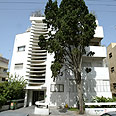
Tel Aviv building
צילום: צביקה טישלר
Tel Aviv, the white city
Swiss exhibit details history of architecture Tel Aviv, the world's first Hebrew-speaking metropolitan city. Show to include photos, models, video and more
GENEVA – The exhibition "Tel Aviv: The White City" is making its first European stop in the Swiss town Mendrizio with an abundance of historical documents, plans, drawings, photographs, models, biographies, video films and animations that together make up a formidable lesson in architecture, even for amateurs.
The exhibition shows an invaluable material which illustrates the design of hundreds of buildings built in the international style, during the period between 1931 and 1948.
Tel Aviv was founded in 1909 and developed as a metropolitan city under the British Mandate in Palestine. The White City was constructed from the early 1930s until the 1950s, based on the urban plan by Sir Patrick Geddes, reflecting modern organic planning principles.
The buildings were designed by architects who were trained in Europe where they practiced their profession before immigrating. They created an outstanding architectural ensemble of the modern movement in a new cultural context.
Essential heritage
The exhibition, which was initially presented in Montreal, was set up to celebrate the accession of the city to UNESCO list of World Heritage sites in 2003. The move put Tel Aviv on a par with the Grand Canyon, Egypt’s pyramids, Peru’s Machu Picchu and Westminster Abbey in the UK – sites whose disappearance, the organisation says, “would be an irreparable loss for each and every one of us”.
Israeli conservationists were elated. At the time, Michael Turner, the honorary chairman of the Israel World Heritage Committee, said: “It’s like the world giving us a mirror to look at ourselves, saying, ‘You have something absolutely beautiful’.”
In practical terms, joining the list is the key to funding that would make the White City shine again, said Nitza Szmuk, who helped promote UNESCO’s recognition of Tel Aviv’s unique cityscape. “There are (grant-giving) foundations for which the primary condition is that the site be recognized by UNESCO” she explained.
Tel Aviv: outstanding planning
Tel Aviv was selected both for its outstanding city planning and architecture that was strongly influenced by the European modernist movement, but were at the same time adapted to the cultural and climatic conditions of the place, as well as being integrated with local traditions.
Szmuk, who is the exhibition’s curator, also authored the remarkable catalogue “Houses on the sand, Tel Aviv. Modern movement and Bauhaus spirit” .
"Tel Aviv: The White City" is on show at the Galleria dell’ Academia in Mendrizio until 23 March 2006. After that the exhibition will be moved to Lausanne at the Federal Polytechnic School from 23 May to 23 June 2006.
Article published by arrangement with European Jewish Press, a pan-European news agency based in Belgium










